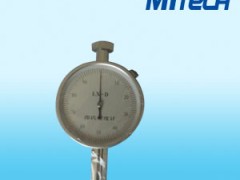Type A: applicable to general rubber, synthetic rubber, vulcanized rubber, soft rubber, leather, wax, etc.
Type C: applicable to the hardness test of rubber microporous material.
Type D: applicable to hard rubber, hard resin, acrylic, glass, cushiony plastic cement, printing plates, fiber, etc.
Ⅰ. Major performances
Shaw rubber hardness gauge is an apparatus to measure vulcanized rubber and plastic products. This apparatus has three models of Type A, Type C and Type D, and each model is subdivided into two types of single pointer and double pointer.
Type A and D respectively are applicable to the testing of low and medium hardness, and high-hardness materials.
Type C applies to the testing of microporous material which is used to make shoes, with compression rate 50 percent, stress 0.049 MPa or above, and this kind of material is made of rubber plastic and has blister in plastic.
Shaw rubber hardness gauge is an apparatus to measure vulcanized rubber and plastic products. This apparatus has three models of Type A, Type C and Type D, and each model is subdivided into two types of single pointer and double pointer.
Type A and D respectively are applicable to the testing of low and medium hardness, and high-hardness materials.
Type C applies to the testing of microporous material which is used to make shoes, with compression rate 50 percent, stress 0.049 MPa or above, and this kind of material is made of rubber plastic and has blister in plastic.
This hardness gauge conforms to the regulations of GB/T531-99, GB2411-80, hg/t2489-93, JJG304-2003.
Ⅱ. Main technical parameters
|
|
Type A
|
Type C
|
Type D
|
|
Calibration Value
|
0-100HA
|
0-100HC
|
0-100HD
|
|
Resolution
|
1HA
|
1HC
|
1HD
|
|
Pressure Head Size
|
Φ1.25mm
|
R2.5mm
|
Φ1.25mm
|
|
End pressure of Pressure Head
|
0.55N-8.06N
|
0.55N-8.06N
|
0-44.5N
|
|
Pressure Needle Range
|
0-2.5mm
|
||
|
Apparatus Weight
|
0.3kg
|
||
Ⅲ. Using methods
When using single pointer models, one should place the sample in the solid plane, hold the hardness gauge, keep the pressure needle at a distance of at least 12 mm from the edge of the sample, smooth enough pressure in the pressure on the sample, and smoothly press on the sample to a full extent. One should press the pressure needle vertically to the sample, and until pressed to a full extent and contact the sample completely, then read the calibration value within one second.
At measuring points which are at least 6 mm away from each other, measure hardness values for five times, and calculate the average value(for microporous material, the distance between the measuring points should be at least 15 mm). In order to keep the stability of conditions and improve the accuracy of determination, one should install the hardness gauge on the same type of the measuring shelf from a complete production network. When using double pointer models to do measurement, one should rotate the supporting pointer to the wax, etc.


